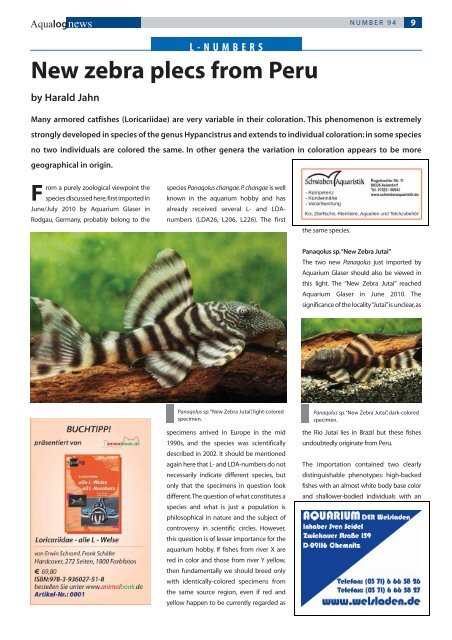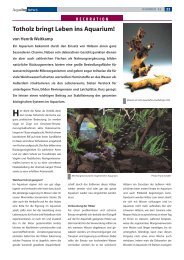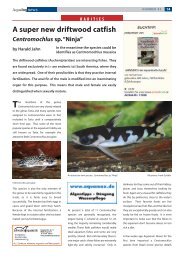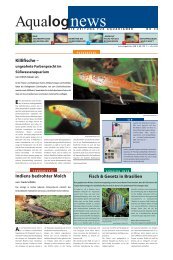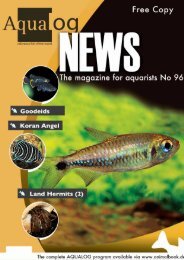LIVEBEARERS T Phallichthys tico - - a dainty new ... - Aqualog
LIVEBEARERS T Phallichthys tico - - a dainty new ... - Aqualog
LIVEBEARERS T Phallichthys tico - - a dainty new ... - Aqualog
You also want an ePaper? Increase the reach of your titles
YUMPU automatically turns print PDFs into web optimized ePapers that Google loves.
<strong>Aqualog</strong><strong>new</strong>s NUMBER 94 9<br />
New zebra plecs from Peru<br />
by Harald Jahn<br />
Many armored catfishes (Loricariidae) are very variable in their coloration. This phenomenon is extremely<br />
strongly developed in species of the genus Hypancistrus and extends to individual coloration: in some species<br />
no two individuals are colored the same. In other genera the variation in coloration appears to be more<br />
geographical in origin.<br />
F<br />
rom a purely zoological viewpoint the<br />
species discussed here,first imported in<br />
June/July 2010 by Aquarium Glaser in<br />
Rodgau, Germany, probably belong to the<br />
L-NUMBERS<br />
species Panaqolus changae.P.changae is well<br />
known in the aquarium hobby and has<br />
already received several L- and LDAnumbers<br />
(LDA26, L206, L226). The first<br />
Panaqolus sp.“New Zebra Jutai”, light-colored<br />
specimen.<br />
specimens arrived in Europe in the mid<br />
1990s, and the species was scientifically<br />
described in 2002. It should be mentioned<br />
again here that L- and LDA-numbers do not<br />
necessarily indicate different species, but<br />
only that the specimens in question look<br />
different.The question of what constitutes a<br />
species and what is just a population is<br />
philosophical in nature and the subject of<br />
controversy in scientific circles. However,<br />
this question is of lesser importance for the<br />
aquarium hobby. If fishes from river X are<br />
red in color and those from river Y yellow,<br />
then fundamentally we should breed only<br />
with identically-colored specimens from<br />
the same source region, even if red and<br />
yellow happen to be currently regarded as<br />
the same species.<br />
Panaqolus sp.“New Zebra Jutai”<br />
The two <strong>new</strong> Panaqolus just imported by<br />
Aquarium Glaser should also be viewed in<br />
this light. The “New Zebra Jutai” reached<br />
Aquarium Glaser in June 2010. The<br />
significance of the locality “Jutai”is unclear,as<br />
Panaqolus sp.“New Zebra Jutai”, dark-colored<br />
specimen.<br />
the Rio Jutai lies in Brazil but these fishes<br />
undoubtedly originate from Peru.<br />
The importation contained two clearly<br />
distinguishable phenotypes: high-backed<br />
fishes with an almost white body base color<br />
and shallower-bodied individuals with an


